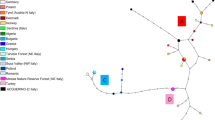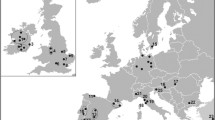Abstract
This study investigates the genetic development of the German Krofdorfer Forst red deer population, located in the federal state of Hesse, by genotyping red deer hunted between 1960 and 1984 (“ancient” population) and between 2002 and 2012 (“extant” population). Krofdorfer Forst belongs to the smaller red deer areas in Hesse, with a census size in spring of 200 animals and is surrounded by areas designated as free of red deer. Because of this “island” position, it should be evaluated whether there was a significant decrease in genetic diversity over time. DNA extracted from bone shavings of antlers and skulls was genotyped with 16 unlinked microsatellites. In the “ancient” population, 131 alleles were detected, from which 39 were private alleles which disappeared from the “extant” population over time. On the other hand, the “extant” population had 112 alleles, from which 20 were new alleles acquired between 1984 and 2012. This means a net loss of 19 alleles over time in the “extant” population. Despite this decrease in genetic diversity, there was a high number of effective alleles as compared to red deer populations in Bavaria. Furthermore, the low F value of 0.032 indicates low (or no) inbreeding and thus a likewise extremely low probability of deleterious alleles to become fixed. Using demographic data obtained from the red deer association of the Krofdorfer Forst, the effective population size was calculated to be 73, which reflects an increase in inbreeding of only 0.7 % per generation which confirms the low F value.

Similar content being viewed by others
References
Alcala N, Streit D, Goudet J, Vuilleumier S (2013) Peak and persistent excess of genetic diversity following an abrupt migration increase. Genetics 193:953–971
Allentoft ME, Collins M, Harker D, Haile J, Oskam CL, Hale ML, Campos PF, Samaniego JA, Gilbert MTP, Willerslev E, Zhang G, Scofield RP, Holdaway RN, Bunce M (2012) The half-life of DNA in bone: measuring decay kinetics in 158 dated fossils. Proc R Soc B 279:4724–4733
Anastassiadis C, Leyhe B, Olsaker I, Friedl R, Rottmann O, Hiendleder S, Erhardt G (1996) Three polymorphic microsatellites for bovine chromosomes 7, 12 and 19. Anim Genet 27:125–126
Bishop MD, Kappes SM, Keele JW, Stone RT, Sunden SL, Hawkins GA, Toldo SS, Fries R, Grosz MD, Yoo J (1994) A genetic linkage map for cattle. Genetics 136:619–639
Cornuet JM, Luikart G (1996) Description and power analysis of two tests for detecting recent population bottlenecks from allele frequency data. Genetics 144:2001–2014
Do C, Waples RS, Peel D, Macbeth GM, Tillett BJ, Ovenden JR (2014) NeEstimator V2: re-implementation of software for the estimation of contemporary effective population size (Ne) from genetic data. Mol Ecol Res 14:209–214
Fickel J, Bubliy OA, Stache A, Noventa T, Jirsa A, Heurich M (2012) Crossing the border? Structure of the red deer (Cervus elaphus) population from the Bavarian–Bohemian forest ecosystem. Mamm Biol 77:211–220
Foerster K, Coulson T, Sheldon BC, Pemberton JM, Clutton-Brock TH, Kruuk LEB (2007) Sexually antagonistic variation for fitness in red deer. Nature 447:1107–1110
Frankham R (1998) Inbreeding and extinction: island populations. Conserv Biol 12:665–675
Harmon LJ, Braude S (2010) Conservation of small populations: effective population sizes, inbreeding, and the 50/500 rule. In: Braude S, Low BS (eds) An introduction to methods and models in ecology, evolution, and conservation biology. Princeton University Press, Princeton, pp 125–138
Hartl GB, Zachos F, Nadlinger K (2003) Genetic diversity in European red deer (Cervus elaphus L.): anthropogenic influences on natural populations. C R Biol 326:S37–S42
Kropil R, Smolko P, Garaj P (2015) Home range and migration patterns of male red deer Cervus elaphus in Western Carpathians. Eur J Wildl Res 61:63–72
Kuehn R, Schroeder W, Pirchner F, Rottmann O (2003) Genetic diversity, gene flow and drift in Bavarian red deer populations (Cervus elaphus). Conserv Genet 4:157–166
Mommens G, Coppieters W, Van de Weghe A, Van Zeveren A, Bouquet Y (1994) Dinucleotide repeat polymorphism at the bovine MM12E6 and MM8D3 loci. Anim Genet 25:368
Moore SS, Byrne K, Berger KT, Barendse W, McCarthy F, Womack JE, Hetzel DJ (1994) Characterization of 65 bovine microsatellites. Mamm Genome 5:84–90
Mukesh, Sharma LK, Kumar VP, Charoo SA, Mohan N, Goyal SP, Sathyakumar S (2013) Loss of genetic diversity and inbreeding in Kashmir red deer (Cervus elaphus hanglu) of Dachigam National Park, Jammu & Kashmir, India. BMC Res Notes 6:326–331
Queirós J, Godinho R, Lopes S, Gortazar C, De la Fuente J, Alves PC (2015) Effect of microsatellite selection on individual and population genetic inferences: an empirical study using cross-specific and species-specific amplifications. Mol Ecol Res 15:747–760
Peakall R, Smouse PE (2006) GENALEX 6: genetic analysis in Excel. Population genetic software for teaching and research. Mol Ecol Notes 6:288–295
Raymond M, Rousset F (1995a) GENEPOP (Version 1.2): population genetics software for exact tests and ecumenicism. J Hered 86:248–249
Raymond M, Rousset F (1995b) An exact test for population differentiation. Evolution 49:1283–1286
Rice WR (1989) Analysing tables of statistical tests. Evolution 43:223–225
Roed KH, Midthjell L (1998) Microsatellites in reindeer, Ragnifer tarandus, and their use in other cervids. Mol Ecol 7:1773–1776
Slate J, Kruuk LEB, Marshall TC, Pemberton JM, Clutton-Brock TH (2000) Inbreeding depression influences lifetime breeding success in a wild population of red deer (Cervus elaphus). Proc R Soc Lond B 267:1657–1662
Slate J, Van Stijn TC, Anderson RM, McEwan KM, Maqbool NJ, Mathias HC, Bixley MJ, Stevens DR, Molenaar AJ, Beever JE, Galloway SM, Tate ML (2002) A deer (subfamily Cervinae) genetic linkage map and the evolution of ruminant genomes. Genetics 160:1587–1597
Steffen P, Eggen A, Dietz AB, Womack JE, Stranzinger G, Fries R (1993) Isolation and mapping of polymorphic microsatellites in cattle. Anim Genet 24:121–124
Stopher KV, Nussey DH, Clutton-Brock TH, Guinness F, Morris A, Pemberton JM (2012) Re-mating across years and intralineage polygyny are associated with greater than expected levels of inbreeding in wild red deer. J Evol Biol 25:2457–2469
Stroehlein H, Herzog S, Hecht W, Herzog A (1993) Biochemical genetic description of German and Swiss populations of red deer Cervus elaphus. Acta Theriol 38:153–161
Thieven U, Harlizius B, Simon D (1995) Dinucleotide repeat polymorphism at the bovine HAUT 1 and HAUT 14 loci. Anim Genet 26:123
Vaiman D, Mercier D, Moazami-Goudarzi K, Eggen A, Ciampolini R, Lépingle A, Velmala R, Kaukinen J, Varvio SL, Martin P, Levéziel H, Guérin G (1994) A set of 99 cattle microsatellites, characterization, synteny mapping, and polymorphism. Mamm Genome 5:288–297
van Oosterhout C, Hutchinson WF, Wills DPM, Shipley P (2004) MICRO-CHECKER: software for identifying and correcting genotyping errors in microsatellite data. Mol Ecol Notes 4:535–538
Walling CA, Nussey DH, Morris A, Clutton-Brock TH, Kruuk LEB, Pemberton JM (2011) Inbreeding depression in red deer calves. BMC Evol Biol 11:318–330
Wang M, Schreiber A (2001) The impact of habitat fragmentation and social structure on the population genetics of roe deer (Capreolus capreolus L.) in Central Europe. Heredity 86:703–715
Weir BS, Cockerham CC (1984) Estimating F-statistics for the analysis of population structure. Evolution 38:1358–1370
Whitlock MC (2000) Fixation of new alleles and the extinction of small populations: drift load, beneficial alleles, and sexual selection. Evolution 54:1855–1861
Wilson C, Strobeck L, Wu J, Coffin JW (1997) Characterization of microsatellite loci in caribou Rangifer tarandus, and their use in other artiodactyls. Mol Ecol 6:697–699
Zachos FE, Hartl GB (2011) Phylogeography, population genetics and conservation of the European red deer Cervus elaphus. Mammal Rev 41:138–150
Zachos FE, Althoff C, von Steynitz Y, Eckert I, Hartl GB (2003) Genetic analysis of an isolated red deer (Cervus elaphus) population showing signs of inbreeding depression. Eur J Wildl Res 53:61–67
Acknowledgments
The authors greatly appreciate the technical assistance of Mrs Bettina Hopf and the indispensable information about the Krofdorfer Forst red deer area provided by H. Voll, K. Schwarz, and K. Osan.
Author information
Authors and Affiliations
Corresponding author
Ethics declarations
Conflict of interest
The authors declare that they have no competing interests.
Rights and permissions
About this article
Cite this article
Willems, H., Welte, J., Hecht, W. et al. Temporal variation of the genetic diversity of a German red deer population between 1960 and 2012. Eur J Wildl Res 62, 277–284 (2016). https://doi.org/10.1007/s10344-016-0999-8
Received:
Revised:
Accepted:
Published:
Issue Date:
DOI: https://doi.org/10.1007/s10344-016-0999-8




